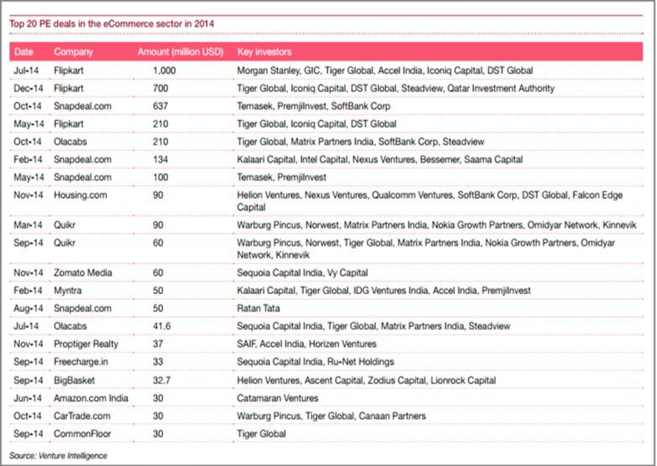It was a very proud moment as International Management Institute, New Delhi conducted its one of a kind entrepreneurial summit ‘Emerge 2015’. The event witnessed the thought provoking interaction from some of the pioneers of E-commerce in India. The topic, which attracted a considerable amount of attention, was about the prevalence of E-commerce ‘bubble’. This piece is all about this ‘bubble’.

In economics, ‘bubble’ is defined as a cycle with rapid expansion followed by a contraction. E-Commerce has been evolving tremendously in India, which is riding on the promise of so called upcoming ‘Ache Din’ and the smartphone revolution. The sector imbibed funding in range of about $5 billion in 2014, that is about 3.5 times of what it got in 2013. The major chunk of this money came from big investors like SoftBank & Tiger-global. The grandeur of this sector can be easily interpreted by this fact, while Flipkart’s value is at $11 billion, traditional players like Future Retail,Pantaloons and Trent are valued at below a billion mark. If the scenario is so upbeat, then what about this ‘bubble’ clamour?
“Where is Flipkart’s complete business model? Forget about valuation. I want to know Flipkart’s business model. I want to know how you will be profitable?” thundered Rakesh Jhunjhunwala in an interview to CNBC-TV18 with fellow investors Ramesh Damani and N. Jayakumar.

A PWC report says E-commerce companies have suffered aggregate losses of around $156,500,000 due to their cash-burn strategy. But the author is not so convinced with this ‘bubble-theory’. There are 150 million active internet users in India, though less than China’s 550 million, they form a consolidated bloc. Also two-third of them are in the age bracket of 29-35, they are the energetic lot, having the capacity to break or build a brand. The prime example of this is Facebook, which clocked the fastest user growth from India. The author agrees that Internet penetration is very dismal in India, but it has been compensated by cheap internet enabled smartphones to a very great extent.

Though connectivity is vital, the real growth would dawn with the increase of purchasing power of an average Indian. The per capita net national income (NNI) of India at current prices during 2014-15 is estimated at 87,748 Indian rupees as compared to 80,388 INR for the year 2013-14, showing a rise of 9.2 percent. The growth from Tier 2 and 3 cities is tremendous, where people have finite reach to brands but have high longings.
As per site monitors, these towns have witnessed a 30% to 50% increase in transactions. With the increase of double income households in India, people are finding hard to spend time with family, so E-Commerce sites are coming very handy. Also the worsening traffic and pollution woes in Indian metropolises restrict frequent shopping outings. Emulating China as a benchmark corroborates the argument that Indian scenario in 2019-20 will be similar to that of China’s in 2012, clearly auguring the vast opportunities waiting to be found in terms of E-Commerce.

Considering that the E-Commerce sector is at its nascent phase, it is very vital to create a base of loyal customers by giving them lucrative offers and discounts. Price has been a crucial factor for an Indian customer and he does not shy to change his loyalty. So this stage becomes much tough in India. India is the only country apart from Kenya, where Uber has Cash on Service facility. The E-Commerce industry can be complementary to many offerings like education, health, hospitality and what not. This advantage for an E-tailler over a brick-and-mortar player allows him to offer significant discounts by leveraging the higher margins, which is a win-win proposition. In addition to E-shopping, customers are also shopping online for occasions like marriages and parties; it is due to huge offerings of items and aggressive campaigns. Creative concepts such as ‘Big Billion Day’ are icing on the cake.

The ease of entry to the market that proliferation of Internet has provided is enabling many players to compete in the market, giving Indian consumers many options and in a way making the competition throat-cutting. For the efficient running of the E-Commerce industry, three things are crucial – handling an inventory of both short and long tail items by the companies in the fray, providing a delightful and secure online surfing and shopping experience to the customers, and ensuring a strong logistical delivery channel. Companies are committed to work upon first two criteria and they are doing great, but the third one is the criterion where India with its present infrastructural red tapes needs more.
The advent of new government has given rise to a new hope. If an industry stalwart like Mr.Ratan Tata is lending his trust to new E-Ventures and the Giants of E-Commerce like Amazon & Alibaba are investing fortunes in India, then it indicates that E-Commerce is going to stay.
Like every sector, the author agrees that not every entrant getting funding will be viable in long run. Some consolidation will take place, especially if money is guzzled out for long. India is yet to get its own Amazon or Alibaba, and for the investors playing prudently, the picture is rosy ahead. The ‘bubble’ may burst for others.
References
1) Business Standard: Here’s why Rakesh Jhunjhunwala is right about the e-commerce bubble, 10:03:2015
2) DNA India: E-commerce: Rs 1000 crore loss due to discounts, report says, 15:02:2015
3) http://statisticstimes.com/economy/gdp-capita-of-india.php

Well analyzed !!
LikeLiked by 1 person
Best analysis done!!!
Even government need to amend the laws relating to taxation and others for clear future of E-commerce industry.
LikeLike